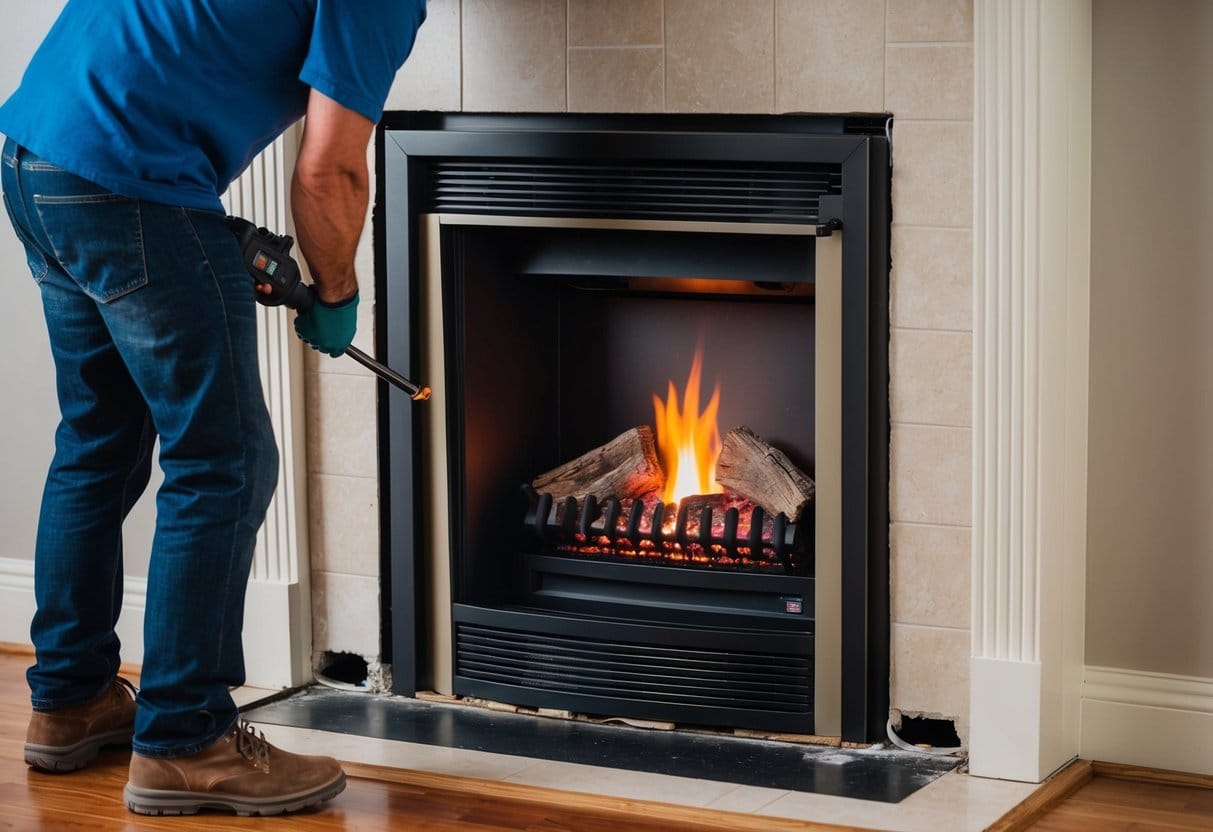
Can Gas Fireplace Be Converted to Electric: A Comprehensive Guide
Gas fireplaces have long been a staple in home heating, offering warmth and aesthetic appeal. Yet, as sustainability becomes more prioritized, homeowners are considering alternatives like electric fireplaces. Yes, gas fireplaces can indeed be converted to electric. This transition not only promises increased energy efficiency but also contributes to a greener environment, as electric fireplaces produce no carbon emissions.
The conversion process involves several key steps, including disconnecting the gas line and removing existing fixtures. It’s crucial to ensure safety measures are followed, such as capping the gas line securely. For many, the prospect of an electric fireplace comes with the added benefit of simplicity, as they require minimal maintenance compared to traditional gas models. The conversion may also prove financially advantageous in the long run, due to lower operating costs.
Those considering this change should weigh the costs associated with the conversion against the potential savings, factoring the investment into their decision. Beloved for their versatile designs and adaptability, electric fireplaces can seamlessly integrate into various home styles. As this trend grows, more individuals are finding electric models to be an attractive and practical choice that meets both aesthetic and functional needs.
Key Takeaways
- Gas fireplaces can be converted to electric.
- Electric fireplaces offer energy efficiency and cost savings.
- Conversion involves specific steps and safety measures.
Assessing the Feasibility of Conversion
Converting a gas fireplace to an electric model involves evaluating both the physical space and the condition of existing structures. Key considerations include the compatibility of your current setup and any structural modifications needed.
Compatibility of Space and Structure
Space compatibility checks whether an electric insert can be safely and efficiently installed in the existing fireplace area. The electric inserts vary in dimensions, so it’s crucial to measure the fireplace opening accurately.
Additionally, consider the surrounding materials. Heat-resistant materials are less of a concern compared to gas or wood-burning fireplaces, reducing potential renovation costs. Assess the proximity of electrical outlets to ensure a power source is accessible without extensive rewiring.
Table: Fireplace Measurements and Insert Sizes
| Measurement | Required Action |
|---|---|
| Width and Height | Match with insert dimensions |
| Depth | Check insert’s depth fitting |
| Outlet Presence | Nearby or need installation |
Analyzing Existing Gas Fireplace and Chimney Condition
Understanding the condition of existing components like the gas fireplace and chimney is essential. First, inspect the gas supply lines and ensure they’re capped and sealed securely if the conversion is chosen.
Check the chimney structure if it will remain in use; it should be in good condition without blockages, since electric fireplaces don’t require ventilation.
Checklist: Gas Line and Chimney Inspection
- Gas Line: Cap securely
- Chimney Blockages: Remove if found
- Structural Integrity: Ensure no repairs needed
Understanding the Conversion Process
Converting a gas fireplace to an electric one requires a few essential steps. These include removing the existing gas fireplace, ensuring proper electrical connections, and installing the electric insert correctly. Each step is crucial for a successful and safe conversion.
Removing the Gas Fireplace
The process begins with removing the gas fireplace. First, disconnect the gas line carefully to prevent any gas leaks. It’s important to turn off the gas supply before starting.
After removing the gas logs or burner, check for any residue or potential fire hazards. Seal the gas line securely using pipe sealing tape and a safety cap.
These steps ensure that the fireplace cavity is ready for the electric insert and that safety concerns are addressed.
Electrical Connections and Requirements
Proper electrical connections are vital. An electric fireplace insert requires a dedicated circuit to handle the power load.
Before installing, inspect the wiring to ensure its capacity suits the electric insert’s requirements. If additional electrical work is needed, hiring a certified electrician is recommended to maintain safety.
Ensure that all electrical components are grounded properly and follow local electrical codes and standards. This step is essential to avoid potential electrical hazards and to ensure the electric fireplace operates efficiently.
Installing the Electric Insert
Once the area is prepared, installing the electric insert is straightforward. Position the insert within the fireplace opening, ensuring it fits snugly.
Mounting hardware is usually provided by the manufacturer and should be used to secure the unit. Connect the insert’s electrical cord to the dedicated circuit established earlier.
The insert should sit flush with the fireplace frame for a clean appearance. Test the unit to confirm it functions correctly, checking both the electrical connections and the operational features of the insert. Proper installation ensures not only functionality but also an aesthetic finish that enhances the room’s ambiance.
Benefits and Considerations of Electric Fireplaces
Electric fireplaces offer several benefits, including lower maintenance and enhanced safety features compared to their gas counterparts. They can also contribute to better air quality and have a lower environmental impact.
Maintenance and Convenience
Electric fireplaces are renowned for their minimal maintenance requirements. Unlike gas models, they don’t require regular chimney cleaning or inspections. Users can enjoy the warmth without worrying about soot accumulation or vent blockages.
The convenience of electric fireplaces is enhanced by features like remote controls, allowing users to adjust settings from afar. Many models also offer customizable flame effects, providing ambience without the hassle of tending to a fire. This makes them a practical choice for those seeking simplicity and ease of use.
Safety and Air Quality
Safety is a significant advantage of electric fireplaces. They eliminate risks associated with gas leaks and carbon monoxide exposure, ensuring better indoor air quality. By not burning fuels, electric fireplaces contribute to a healthier living environment.
Additionally, since they operate on electricity, they don’t produce smoke or harmful emissions. This feature aligns with standards set by the Environmental Protection Agency, making them an ideal choice for households concerned about air quality.
Energy Use and Environmental Impact
Electric fireplaces are energy-efficient and can often be plugged into a standard home outlet. Their use of clean energy reduces reliance on gas, contributing to lower carbon emissions. This can make them a more sustainable option for environmentally conscious homeowners.
While the initial purchase and installation may involve costs, the potential savings in energy bills can be notable. The ability to heat specific areas of a home without utilizing a central system further enhances their efficiency. These factors make electric fireplaces a viable choice for those prioritizing sustainability and cost-effectiveness.
Costs and Investment
Converting a gas fireplace to an electric model involves both upfront expenses and potential long-term savings. By evaluating the initial conversion costs and considering the financial benefits over time, homeowners can make informed decisions.
Initial Conversion Costs
Initial expenses for this project can vary widely. The price of an electric fireplace unit ranges from $300 to $1,500. This variation depends on factors like size, style, and additional features. Labor costs for installation usually range between $150 and $2,200, influenced by local rates and the complexity of any needed electrical work. It’s also worth considering if chimney cleaning or installation of a chimney cap is required, as these can add to the expense.
Electric fireplaces generally require less maintenance, so upfront costs might seem higher but can balance out over time. Compared to the initial installation of a gas model, electric units often involve fewer safety precautions, which might also reduce labor charges.
Long-Term Financial Benefits
Electric fireplaces offer significant long-term financial benefits. The average cost to operate is roughly $0.13 per hour, compared to nearly $1.00 for a gas fireplace. This reduction in energy costs can lead to substantial savings on heating bills over time. Additionally, electric fireplaces involve lower ongoing maintenance costs since they do not require regular chimney cleaning or other servicing associated with gas fireplaces.
Further savings can emerge from increased energy efficiency, reducing overall household utility expenses. As a home improvement project, switching to electric can also potentially enhance property value. Electric units tend to be safer, with fewer risks associated with gas leaks, contributing positively to household safety without the need for frequent inspections.
Finalizing Your Electric Fireplace Conversion
Completing the conversion of a gas fireplace to an electric one involves ensuring the installation is up to code and adding finishing touches to enhance the look of the fireplace. These steps are essential for both safety and aesthetic appeal.
Inspection and Compliance
After installing the electric fireplace insert, it’s crucial to conduct a comprehensive inspection. A certified professional should review the setup to ensure all electrical connections are secure and compliant with local building codes. This includes verifying that the correct voltage is used and that the installation is grounded properly.
Ensuring compliance not only guarantees safety but also helps in efficiently managing the BTUs produced by the electric unit. Additionally, confirm that no residual gas lines are exposed and that all previous gas components are safely sealed. Adhering to these safety measures prevents any potential hazards and maintains the efficiency of the new electric system.
Aesthetic Finishing Touches
The aesthetic aspect of the conversion should not be overlooked. Start by choosing a fireplace surround that complements the existing room decor. Options range from traditional wood mantles to sleek, modern glass finishes, allowing homeowners to tailor the design to their tastes.
Consider adding lighting enhancements, such as LED strips, around the insert to emphasize the ambiance. Decorative accents like stone veneers or tile work can further elevate the look. By focusing on these elements, the electric fireplace becomes not only a functional heat source but also a stunning focal point within the home.
Frequently Asked Questions
Converting a gas fireplace to an electric one involves considerations around cost, installation steps, and benefits. It is also possible to explore alternative conversion options, such as converting to a wood-burning setup.
How much does it cost to convert a gas fireplace to electric?
The cost to convert a gas fireplace to electric generally ranges from $500 to $3,500. This depends on the model of electric insert chosen and labor involved. Custom or high-end finishes can increase costs. Always obtain multiple quotes from professionals to ensure a fair price.
What steps are involved in changing a gas fireplace to an electric one?
Key steps include turning off the gas supply and ensuring the fireplace is cooled. Decorative elements like logs should be removed, and the gas line must be sealed safely. The electric insert is then installed following manufacturer’s instructions and connected to a dedicated circuit.
Is it possible to place an electric insert into an existing gas fireplace?
Yes, electric inserts can often be placed into existing gas fireplaces with some modifications. The gas fireplace’s structure usually needs adjustments for the electric insert to fit properly. Consulting with professionals can ensure a safe and effective installation.
Are there any specific considerations when replacing a gas fire with an electric one?
Ensure that the home’s electrical system can support the new electric load. Adequate ventilation is not as crucial as with gas fireplaces, but design preferences and dimensions must align. It is also essential to cap and seal the gas line to prevent leaks.
What are the benefits of converting a gas fireplace to electric?
Electric fireplaces offer energy efficiency and lower maintenance needs. They eliminate combustion-related concerns and offer a safer alternative for households with children or pets. Additionally, they provide versatile design options and flexibility in installation locations.
Can a gas fireplace be easily converted to wood instead of electric?
Converting a gas fireplace to wood is more complex than converting to electric. It involves structural changes, the addition of a chimney or flue, and compliance with local building codes. This option is less straightforward and often more costly than other conversions.


